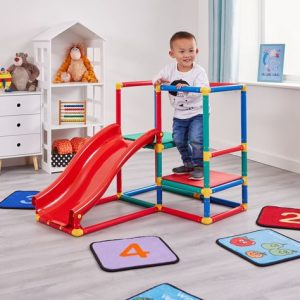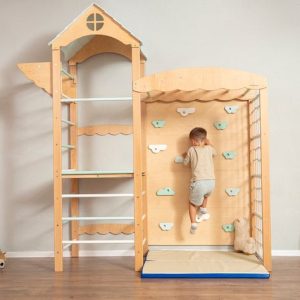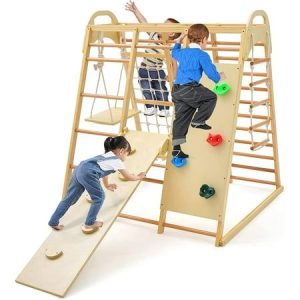What age are play gyms for? Play gyms are colorful, stimulating mats and arches filled with toys and textures designed for babies. They are a common sight in homes with little ones, but you might wonder exactly when babies benefit most from them. This guide will explore the developmental stages that play gyms can support and answer the question: “What age are play gyms for?”
Understanding Developmental Milestones
Babies develop rapidly in their first year, reaching new milestones almost every month. Here’s a quick look at some key milestones to consider:
-
Newborn (0-3 Months): During this time, babies focus on developing their senses – sight, sound, touch, taste, and smell. They primarily see in black and white and at close range. Their movements are reflexive.
-
2-4 Months: This is when babies start to develop more control over their head and neck movements. They begin to track objects with their eyes and reach for them with their hands.
-
4-6 Months: Around this time, babies gain more control over their upper body movements and can roll from front to back and back to front. They love to grab objects and bring them to their mouth.
-
6-9 Months: This stage is marked by increased mobility. Babies can sit with support and are starting to crawl. They explore objects with their hands and mouth and love to babble and experiment with sounds.
-
9-12 Months: By 9 months, most babies can sit independently and are pulling themselves up to stand. They are becoming more coordinated and can pick up small objects with their thumb and forefinger.
Knowing these milestones can help you understand how a play gym can support your baby’s development at different stages.

How Play Gyms Support Early Development
What age are play gyms for? Play gyms offer a safe and stimulating environment for babies to explore, learn, and grow. Here’s a breakdown of the benefits they provide at different stages:
-
Newborns (0-3 Months): High-contrast colors, shapes, and mobiles on a play gym can visually stimulate newborns. The soft textures and gentle sounds can be calming and promote relaxation.
-
2-4 Months: As babies gain more neck control, they can spend more time on their tummy on the play gym mat. This tummy time is crucial for strengthening neck and back muscles. The dangling toys will entice them to reach and bat, promoting hand-eye coordination.
-
4-6 Months: Play gyms offer a fun and safe space for babies to practice reaching, grasping, and manipulating toys. The different textures and sounds will keep them engaged and curious.
-
6-9 Months: Crawling babies can explore the play gym from different angles. The variety of toys will encourage them to explore cause and effect, such as pressing buttons to make sounds or pulling on strings to activate toys.
-
9-12 Months: Play gym toys can become props for imaginative play at this stage. Babies might use them to pretend to talk on the phone or sort objects into containers.
Overall, play gyms can be a valuable tool to support your baby’s physical, sensory, cognitive, and social development.

Signs Your Baby Might Have Outgrown the Play Gym
While play gyms offer many benefits, there comes a time when babies might not find them as engaging anymore. Here are some signs your baby might have outgrown their play gym:
-
They can easily climb out of the play gym.
-
They are no longer interested in the toys and prefer to explore other areas.
-
They are becoming more mobile and interested in interactive toys that require walking or running.
-
They seem frustrated with the limitations of the play gym.
If you notice these signs, it might be time to pack up the play gym and transition to other toys and play areas that are more appropriate for your baby’s current developmental stage.
The Takeaway: Play Gyms Are a Valuable Tool for Early Development
Play gyms are a fantastic tool to support your baby’s development from the newborn stage to around their first birthday. They provide a safe and stimulating environment for babies to explore, learn, and grow. By understanding your baby’s developmental milestones, you can maximize the benefits of a play gym and know when it’s time to move on to other play experiences.
So spread out that play gym mat, hang the colorful toys, and watch your baby embark on a wonderful journey of discovery!

Signs Your Baby Might Have Outgrown the Play Gym
Play gyms are fantastic for the first year of a baby’s life, but there comes a time when they might not be as engaging anymore. Here are some signs your baby might be ready for new challenges:
-
They can easily climb out of the play gym. This can be a safety hazard.
-
They are no longer interested in the toys and prefer to explore other areas of the house. This is a sign they’re curious about their surroundings and ready to interact with the world in new ways.
-
They are becoming more mobile and interested in toys that require walking or running. Push toys, ride-on toys, and balls might become more interesting at this stage.
-
They seem frustrated with the limitations of the play gym. This might mean they’re ready for more complex toys and activities that challenge them mentally and physically.
If you notice these signs, it might be time to pack up the play gym and transition to other toys and play areas that are more appropriate for your baby’s current developmental stage.

The Joy of Exploration: Beyond the Play Gym
What age are play gyms for? There’s a whole world of exploration waiting for your curious baby! Here are some ideas for expanding their playtime horizons:
-
Set up safe play areas around the house. This could include a designated spot for building with blocks, a comfy corner for reading books, or a space for playing with toy cars.
-
Provide open-ended toys that encourage creativity. Blocks, balls, nesting cups, and shape sorters are all great options that can be used in many different ways.
-
Get down on the floor and play with your baby! This is a wonderful way to bond and show them how to use toys and explore their surroundings.
-
Sing songs, read stories, and have dance parties! Interactive play is a great way to promote language development, social skills, and physical coordination.
Remember, the most important thing is to provide a safe and stimulating environment where your baby can explore, learn, and grow at their own pace.

